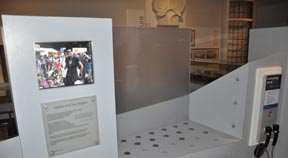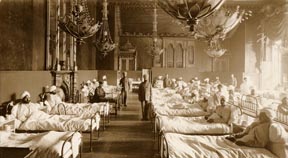My partner and I were visiting Sussex from California and met with some old friends from Brighton who took us out for a delicious lunch then on to the cultural quarter to show off the delights of your heritage in Brighton. We loved the over the top Royal Pavilion and found the museum interesting but kept asking our Brighton friends “where is the gay stuff”.
We are used to the social heritage and history of a city and country being proudly displayed along side curios, furniture and architectural fragments. We were shocked that when we eventually found a small exhibit labeled gay and lesbian Brighton it contained nothing, just a few sounds bits and a film about Pride from some years ago that seemed to be full of drag queens and young drunken people. I took some photo’s of it.
We were both surprised and with our friends offended by the unexplainable lack of representation of the huge LGBT population of the city, it’s lack of representation in the rest of the collection and the careful editing out of obvious LGBT content other than objects that screamed their gay heritage at you, a rather nice Bronze of a man, a few paintings, a photograph.
We were curious to know why the history of LGBT people in the city wasn’t celebrated, why the movers and shakers of gay life weren’t celebrated and why the crafting of the city by it’s variant gay community and world wide tolerance and inclusion weren’t one of the main permanent exhibits and why the tatty and missing LGBT display, in all it’s tiny invisibility was stuffed along side some seedy sex exhibit and gambling toys. One of the reasons we chose to come to Brighton was because of its reputation for being such a wonderfully gay place, stuffed full of history and fun.
The staff on duty said the exhibition had been like that for some time, rather a long time and there were “plans to update it” but I could find nothing on their website or any kind of notice.
It was a real dampener to an otherwise splendid day and it’s not often I find myself being ashamed for another city, particular not when I’m being shown them around a museuam that seems to have benefited from a lot of money and an awful lot of LGBT bequests and loans too as many of the items on display could only have been bought by a gay man. I talked to an associate who works in the Victoria and Albert Museum in London and he said it is a matter for the museum staff and curators to decide which parts of the permanent collections are on display.
What has happened to your gay history, where is it gone and why has it allowed to be made so institutionally invisible in a city with such an large LGBT population?
This is a real cultural outrage and should be sorted out by the politicians and curators with some degree of urgency. I’m not sure who funds museums in Brighton but if it is the tax payers then perhaps an American phrase might be useful right now “no taxation without representation”.
Please would you publish my letter and ask the LGBT residents of your wonderful city to start making some noise about this. I thought you Brits were supposed to love your history.
You could go through the entire collection of Brighton Museum and not know about it’s vibrant LGBT history at all, in fact you might come away thinking it had a huge population from Papua New Guinea who had a rather curious obsession with Teapots.
There is no sense of Pride, this is SHAME.
Peter Downton, Laguna Beach, California








You must be logged in to post a comment.